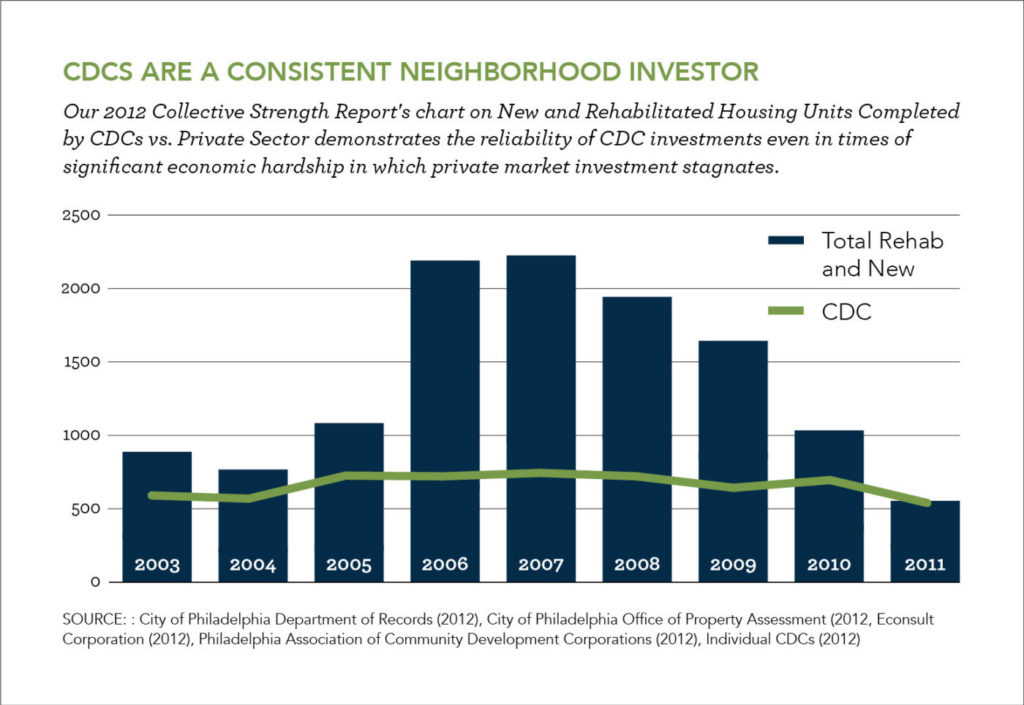Report finds CDCs produce $5.4 billion of economic growth in Philadelphia
 November 13, 2020
Category: Featured, Long, Purpose
November 13, 2020
Category: Featured, Long, Purpose
The Philadelphia Association of Community Development Corporations released a report in October, finding CDCs in Philadelphia have generated $5.4 billion into the local Philadelphia economy throughout the past 28 years.
In Pennsylvania as a whole, CDCs have contributed to $9 billion in economic growth during that same time, according to the report.
“I think it shows that we’re deeply invested in trying to make sure as much of the money that we raise is spent here, hiring people in Philadelphia and Pennsylvania when we can, so that that money is recirculating in the local economy,” said Beth McConnell, policy director of the PACDC, which was formed in 1992.
The Collective Strength Report, which was conducted by Econsult Solutions, looks at the cash flow that CDC project spending injects into the local economy and its secondary effects, like job creation.
Of the total $5.4 billion generated, $3.9 billion went directly toward spending on construction and residential projects. And the remaining $1.5 billion of indirect spending was generated by the purchasing of goods and services by local residents from local vendors.

(Graphic from https://pacdc.org/cdcimpactreport/)
During the time the report analyzes, CDCs completed more than 2,800 construction and renovation projects in Philadelphia. The majority of these projects were residential properties, followed by commercial and mixed-use projects. Between 2007 and 2011 alone, these projects resulted in 3,300 new and rehabilitated housing units.
“The need for affordable housing is just tremendous,” said Majeedah Rashid, chief operating officer of Nicetown CDC.
Nicetown CDC created two affordable housing developments throughout the last decade: Nicetown Court One and Nicetown Court Two. Both developments sit on the 4300 and 4400 block of Germantown Avenue, respectively, and provide a combined 87 rental units to the North Philadelphia community.
“We still have a long waiting list for both of those developments,” Rashid added.
Similarly, HACE, which operates in the Fairhill and St. Hugh neighborhoods of the city, has developed 438 affordable rental housing units, including 250 units for senior citizens.
“Through affordable housing we are really in essence rebuilding communities,” said María N. Gonzalez, president and CEO of HACE.
“We’re tackling problems related to blight, vacant lots and vacant properties that are being repurposed to provide affordable housing for families,” she said. “And we also revitalize neighborhoods and create a neighborhood economy.”
One secondary effect of construction and renovation projects is job creation. The report found CDC investments created 12,790 full time equivalent jobs in Philadelphia.
Gonzalez saw this first-hand. With the development of HACE’s affordable housing units, 20 permanent positions were created in the community through a property management group.
“As we develop more affordable housing, we have site managers and also maintenance staff positions that are created in those developments and in essence we are creating career paths for people in our neighborhood that provides a living wage job with a full complement of benefits for their families,” she said.
Communities are further stabilized by construction projects, whether residential or commercial, by the resulting increase in property values, and thus, household wealth.
The Collective Strength report found CDC projects influenced nearby property values by 5.9 percent on average, resulting in a $2.4 billion increase in property values within Philadelphia.
In addition to residential developments, CDCs also often focus on residential corridor improvements by renovating storefronts to enhance the physical environments of neighborhoods. This contributes to increasing property values, attracting patrons to buy from local vendors and providing jobs to local residents.

(Graphic from https://pacdc.org/cdcimpactreport/)
“Wherever we do development, we try to uplift the area around that development,” said Rashid, noting the commercial spaces at Nicetown Court One and Two. “So it’s not like a rocket ship coming in and then you have all this blight around it.”
HACE manages two commercial corridors. One is located at 5th and Lehigh streets and the other at Front Street and Allegheny Avenue. There you can find bakeries, pharmacies, salons and more.
“We’ve also provided spaces for a barber shop, phone stores and now we’re looking to attract restaurants so we can showcase and brand our neighborhood as a center of commerce for Latino goods and services,” Gonzalez said. “You bring employers, you provide jobs or give young entrepreneurs the opportunity to create a business.”
Alex Balloon, director and corridor manager for Tacony CDC, has seen storefront improvement along the Torresdale Avenue commercial corridor dramatically impact his local neighborhood economy just by investing in small businesses through projects like, painting and hanging awnings.
“What happens is, it’s the snowball effect, other business owners see what’s happening and they say, ‘You know, I want to participate in that,’” he said.
Balloon said home prices in Tacony have increased by 17 percent in the last year and the neighborhoods’ commercial bankruptcy went from about 30 percent to below five percent in the last eight years.
“It’s had a dramatic impact,” he said. “We have fewer vacant buildings than we did eight years ago. People can see before and after.”
The work of CDCs can make neighborhoods more welcoming and visually pleasing for residents, but as the Collective Strength Report found, there are also economic benefits that result.
McConnell said she hopes the findings of the report persuade policymakers in Philadelphia and at the state and federal levels to invest in CDCs, especially in the economic devastation caused by the COVID-19 pandemic.
“Investing in CDCs is an extremely smart strategy and a great return on investments,” she said. “It will allow us to recover and rebuild in a way that is equitable.”
Trending News














